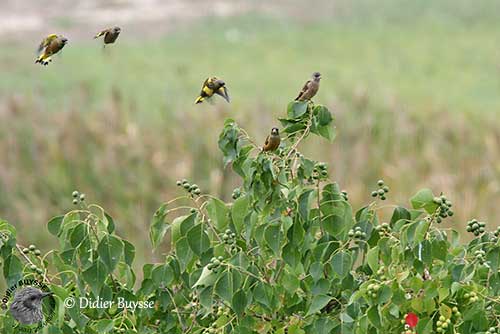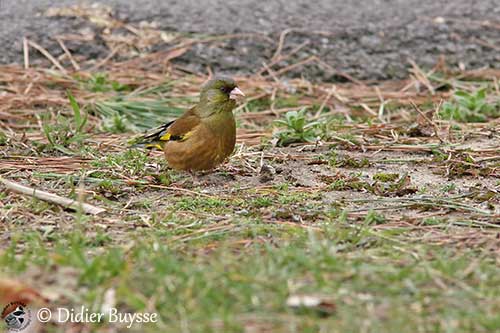
Fr: Verdier de Chine
Ang: Grey-capped Greenfinch - Oriental Greenfinch
All: Chinagrünfink
Esp: Verderón Chino
Ita: Verdone orientale
Nd: Chinese Groenling
Sd: orientgrönfink
Photographers:
Didier Buysse
Vision d’Oiseaux
Ken Havard
My Bird Gallery & Flickr gallery 1 & Flickr gallery 2
Ingo Waschkies
Bird Photography
Text by Nicole Bouglouan
Sources:
HANDBOOK OF THE BIRDS OF THE WORLD Vol 15 by Josep del Hoyo-Andrew Elliot-David Christie - Lynx Edicions – ISBN: 9788496553682
A Field Guide to the Birds of South-East Asia by Craig Robson. New Holland Publishers. ISBN: 9781780090498
FINCHES AND SPARROWS by Peter Clement, Alan Harris and John Davis – Helm Identification Guides – ISBN: 0713652039
Ottaviani, M. (2008) Monographie des Fringilles (fringillinés – carduélinés) – Histoire Naturelle et photographies, Volume 1. Editions Prin, Ingré, France, 488 p
South Dakota Birds and Birding – (Terry L. Sohl)
First record of Oriental Greenfinch (Chloris sinica) for British Columbia and Canada
What Bird-The ultimate Bird Guide (Mitchell Waite)
Wikipedia, the free encyclopaedia
Grey-capped Greenfinch or Oriental Greenfinch
Chloris sinica
Passeriformes Order – Fringillidae Family
INTRODUCTION:
The Grey-capped Greenfinch or Oriental Greenfinch is a medium-sized bird of the east Palearctic. It is resident throughout Asia, from Russia, E to Japan, with some vagrants to W Aleutian Islands and Pribilof Islands during spring migration and summer. Four subspecies share the large range.
It frequents coniferous and deciduous forests, riverbanks, parks and gardens when breeding, and descends to lower areas including near habitations outside of breeding season.
It feeds primarily on a variety of seeds, but small insects are also part of its diet. It nests in a cup-shaped structure placed some metres above the ground in bush or tree.
The Grey-capped Greenfinch or Oriental Greenfinch is described as common to locally common, and currently, the species is not globally threatened.
DESCRIPTION OF THE BIRD:
Biometrics:
Length: 15 cm
Wingspan: 23 cm
Weight: 17-22 g
The male Grey-capped Greenfinch or Oriental Greenfinch has warm brown lower mantle, back and scapulars, whereas the upper mantle is washed olive to grey green. The upper rump is paler, mostly buff-brown, and the lower rump is yellow to yellowish-brown with green edges to feathers. The uppertail-coverts are tipped ash-grey. The short, slightly forked tail is black to blackish-brown, although the central pair of rectrices shows bright yellow bases of outer edges, forming a conspicuous panel at sides of tail base.
On the upperwing, the coverts are olive-brown with bright green wash in fresh plumage. The outer greater coverts are yellow with buff or grey tips. Alula, primary coverts and flight-feathers are black with bright yellow edges at bases, forming a broad, yellow wingbar across the base of the flight-feathers, visible in flight. On closed wings, a greyish/buffy-white panel is formed by the broad edges of secondaries. The primaries have narrow, whitish tips and the tertials are fringed buff-brown to greyish-white.

On the underparts, chin, throat and neck sides are pale yellow to greenish-yellow. The upper breast is warm brown/cinnamon, whereas lower breast and flanks are deeper brown. Belly and undertail-coverts are yellow. On the underwing, the coverts are pale yellow.
On the head, forehead and face are olive-green, sometimes extending to chin and throat. Crown to nape and rear ear-coverts are dark grey to blackish-olive in fresh plumage, becoming darker in worn plumage. The lores are blackish.
The strong, conical bill is pale pinkish. The eyes are dark brown to brownish-black. Legs and feet are pale pink.
The female resembles male but she is duller, with more uniform, greyish-brown head and duller upperparts. The underparts are more washed out.
The juvenile has pale yellowish head and underparts with brown streaking. The upperparts are buff-brown with dark streaks and duller wing-pattern. The young bird is paler with dark lores.
SUBSPECIES AND RANGE:
The Grey-capped Greenfinch or Oriental Greenfinch has four subspecies.
C.s. sinica (described above) is found in C, E and SE China and NE and C Vietnam.
C.s. ussuriensis occurs in NE China, Korea and SE Russia (S Ussuriland).
This race is paler and greyer on head and the underparts are more extensively yellow to yellowish-brown.
C.s. kawarahiba is found in Kamchatka, Sakhalin and Kuril Islands and N Japan (NE Hokkaido). In non-breeding season, it can be found in S to SE China and more rarely in Taiwan.
This one has deep green head with grey tinge and grey moustachial stripe. The upperparts are chocolate-brown with green to washed yellow rump. The underparts are bright cinnamon with yellowish tinge and bright yellow undertail-coverts.
C.s. minor occurs in extreme S Korea and Japan.
This race resembles nominate, but forehead and lores are dark green. Mantle and back are greenish-brown, underparts and neck sides are deep green.
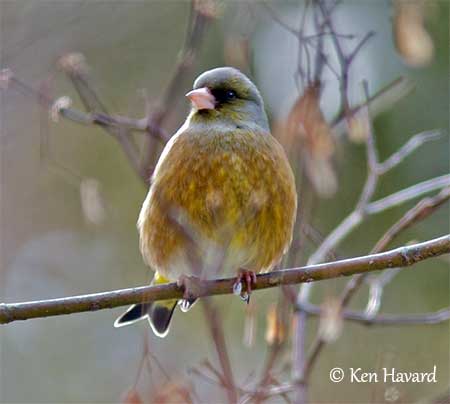
HABITAT:
The Grey-capped Greenfinch or Oriental Greenfinch breeds in coniferous and mixed coniferous-deciduous forests, also in secondary growths, riverbanks, trees and bushes in river valleys, orchards, parks and gardens. It can be seen up to 2,400 metres of elevation.
During migration and outside of breeding season, the species descends to lowlands, plains and coastal fields, and they can be seen near habitations and in urban areas.
CALLS AND SONGS: SOUNDS BY XENO-CANTO
The Grey-capped Greenfinch or Oriental Greenfinch’s calls include a nasal “djeeeeee” and a twittering “dzi-dz-i-dzi-i…”.
The song is a repeated series of phrases including call notes. On the sonogram, the song appears wave-shaped and the bird seems to produce a series of rapid, coarse notes, followed by the nasal “djeeeeee”.
Both calls and song are very similar to those of the European Greenfinch.
BEHAVIOUR IN THE WILD:
The Grey-capped Greenfinch or Oriental Greenfinch feeds mainly on seeds and grains including seeds from weeds and shrubs, sunflower, rice and others. It may occasionally take small insects, spiders and small invertebrates, especially during the nesting period.
It may forage on the ground, in shrubs and low vegetation, and even higher in tree canopy. It can be seen in pairs or in small groups, but outside of breeding season, it forages in large flocks in cultivated areas. They also frequent bird-feeders.
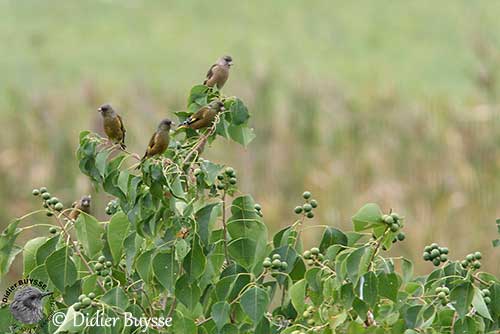
At the beginning of the breeding season, the male performs a butterfly-like aerial display on stiff wings, accompanied by song. The cup-shaped nest is placed in tree or bush.
The Grey-capped Greenfinch or Oriental Greenfinch of the northern range performs altitudinal movements after breeding, to spend the winter at lower elevation. It moves S in September/October within a short distance, and returns to the breeding grounds in April/May.
The flight is swift and undulating, with rapid wingbeats interspersed with short periods of wings pulled to the sides.
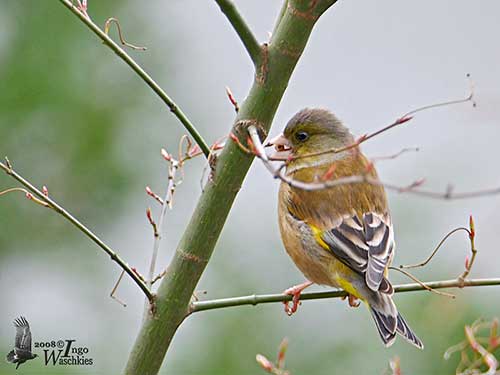
REPRODUCTION OF THIS SPECIES:
The breeding season takes place from March to August. The nest is a deep cup placed in bush, tree or bamboo. It is made with dry grass, vegetal fibres, stems and moss, and the cup is lined with softer material such as animal hair. It is placed between 3 and 9 metres above the ground.
The female lays 3-5 pale blue eggs with brown spots. She incubates alone during 12-15 days. No more information.
PROTECTION / THREATS / STATUS:
The Grey-capped Greenfinch or Oriental Greenfinch is described as common to locally common, but the species is scarce in some regions including Kuril Islands and E Tonkin. The populations of S China and Hong Kong have declined since late 1950s.
The global population size is unknown but it is suspected to be stable.
The Grey-capped Greenfinch or Oriental Greenfinch is not globally threatened, and the species is currently evaluated as Least Concern.
